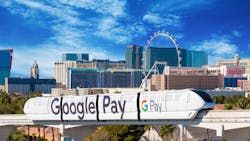Las Vegas Monorail launches first sustainability, climate-themed sponsorship program
The Las Vegas Monorail has partnered with Pharris Medis Inc. to launch a commercial sponsorship program promoting sustainability and climate change awareness as a core part of their sponsorship activation.
The private, nonprofit transit system is working to secure climate-conscious sponsors to create informative and entertaining experiential environments on each of the system’s seven stations and nine trains. This is one of the nation’s first commercial sponsorship programs focused on sustainability and climate change, according to Pharris Media Inc.
"The Las Vegas Monorail is one of the most climate-friendly public transit systems in America," said Curtis Myles, president/CEO officer, Las Vegas Monorail Company. "During the past 15 years, we've carried more than 87 million passengers, removed more than 30 million vehicle miles from Las Vegas Resort Corridor area roadways, and 462 tons of carbon monoxide and other volatile compounds from the atmosphere. This new sponsorship program highlights the system's environmental benefits, furthers our contribution to the reduction of climate change and responds to our customers' interests."
The sustainability-centered sponsorship program is the brainchild of Patrick Pharris, president and CEO of Pharris Media. Pharris created the Monorail's initial sponsorship program, from 2000 – 2007, which secured contracts from such companies as General Motors, Monster Beverage Company, Nextel (later acquired by Sprint), Paramount Parks and Bank of Nevada. The Las Vegas Monorail Company has entered into this new, exclusive agreement with Pharris Media to sell the Monorail's long-term sponsorship program.
"There are a number of brands taking significant steps to advance sustainability and help mitigate climate change," Pharris said. "One of the challenges they face, however, is a unique means by which to communicate these efforts. With the monorail carrying millions of riders each year from all over the world, and its visibility reaching millions more, the monorail presents an unparalleled venue to help brands communicate their messages, engage consumers and encourage action."
The Monorail stations, each nearly 200 feet in length, feature two levels: a platform where riders embark and disembark; and a mezzanine that is the point of entry and exit to the station. The stations' exteriors present massive areas for the exhibition of video and static signage. The interiors present multiple spaces in which sponsors can engage consumers in branded experiences, as well as display interactive and static signage.
Monorail stations are in high profile locations along the Las Vegas Strip Resort Corridor such as MGM Grand; Bally's/Paris Las Vegas; Flamingo / Caesars Palace; Harrah's/The LINQ; Las Vegas Convention Center; Westgate Resort & Casino; and Sahara Las Vegas. There’s also the soon-to-be-built station that will connect the Monorail to four distinct venues: Madison Square Garden Group's "The Sphere"(the 360-foot, 17,000 seat, spherical entertainment venue), the Sands Convention Center, The Venetian and The Palazzo resorts.
With stations designed by Gensler, the 3.9-mile long Las Vegas Monorail connects the resort properties and the Las Vegas Convention Center creating a comfortable and environmentally friendly passenger experience.
"When Gensler designed the Las Vegas Monorail stations, we envisioned a public transit system that could contribute to the future of efficient mobility and a more resourceful, resilient and regenerative environment for Las Vegas," said Andy Cohen, Co-chief executive officer of Gensler. "With zero-emissions trains and the history of removing nearly 2-million vehicle trips a year from the streets of Las Vegas, the Monorail has indeed lived up to the vision. Asking sponsors to further reinforce this vision by promoting sustainability and climate change awareness with both brand and consumer-driven solutions is a visionary move. It shows how we, as global citizens, can work together to profoundly shape the future of cities."



